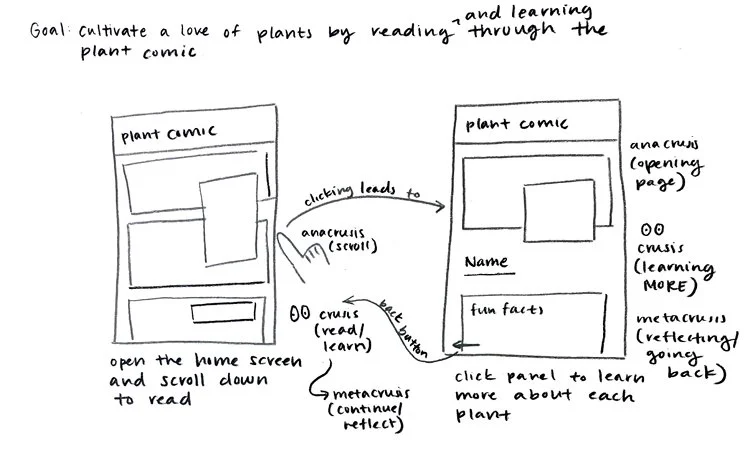
The Secret Life of Plants

Design a plant walk interface that cultivates a love of plants immediately around UT's Art building.
I created a comic-style plant walk around UT’s Art Building to make learning about local plants fun and engaging. The playful format encourages people to slow down, notice, and connect with the landscape while turning an ordinary walk into a memorable experience.
I began with user research, creating a persona to understand needs and motivations. From there, I ideated and prototyped in Figma, refining how the comic could guide attention and spark curiosity. Finally, I implemented the design using HTML and CSS to bring the interactive experience to life.

I started with an autoethnography, which involved walking through the space and paying attention to how we were interacting with the trees and plants. I noticed that the most engaging moments happened while we were learning about the plants, which gave me a good starting point. I also realized that while we were paying attention, we hadn’t quite reached a deeper level of connection—that became a goal for my interface.
Next, I created a persona to better understand who I was designing for. This helped me see the main motivations: wanting to understand, wanting to take part, and wanting to enjoy the walk. Keeping these needs in mind gave me direction on how the interface should feel and what it should offer.
I then mapped out the user’s journey. The strongest moments of focus and enjoyment seemed to come during and after learning about the plants. Since that’s also when curiosity and appreciation keep growing, I designed the interface to spend more time in that stage of the experience.
Using my research, I formulated a central design question:
How might we shift UT students’ perspective of ordinary plants around them so that they become sources of interest and meaning?

For this stage, I explored different directions before deciding on a web comic as my interface. I was drawn to the idea of weaving narrative into the experience—comics felt like a fun and unexpected way to “hook” users and make learning about plants more enjoyable. Unlike my other ideas, which relied on users already being interested in related topics, the comic format creates its own appeal through story and playfulness.
This decision helped me move from a vague concept to a clear design goal: learning through a medium that feels lighthearted and surprising. My persona reinforced this choice by highlighting users’ need for understanding, participation, and leisure, all of which could be met through a comic. Creating an early hypothesis and sketch also helped me visualize what I wanted to design and identify the key aspects I needed to include.
After narrowing down the concept, I gathered visual inspiration for both the comic-style landing page and the individual plant pages. Looking at examples of web comics, playful layouts, and plant-focused interfaces helped me imagine how narrative and learning could come together visually. This step guided my choices for tone, style, and how information should flow between the story and the plant details.

With my concept defined, I created a mid-fidelity prototype with annotations in Figma to map out the structure and flow of the interface. This helped me test how the comic-style narrative and plant information pages would connect.
Alongside the prototype, I built a style guide to establish consistency in typography, and color. Together, these gave me a strong foundation for moving into implementation.

After prototyping, I built the interface using HTML and CSS. This step brought the comic-style design to life, translating the narrative flow and plant pages from static mockups into an interactive experience.

Final thoughts
Role: Product designer
Class: Interaction Design
Timeline: 4 weeks, Fall 2025
Skills: UX/UI, User Research, Wireframing, HTML/CSS
Tools: Figma, Visual Studio Code, Github
This project was a rewarding opportunity to go through the full design process—from research to ideation, prototyping, and finally implementation. I especially enjoyed designing for the user in a unique way, using comics to create an engaging and playful experience. It was also exciting to see my ideas come to life, and I found a lot of satisfaction in building the interface with HTML and CSS. The project not only strengthened my design process skills but also deepened my appreciation for turning creative concepts into working experiences.







